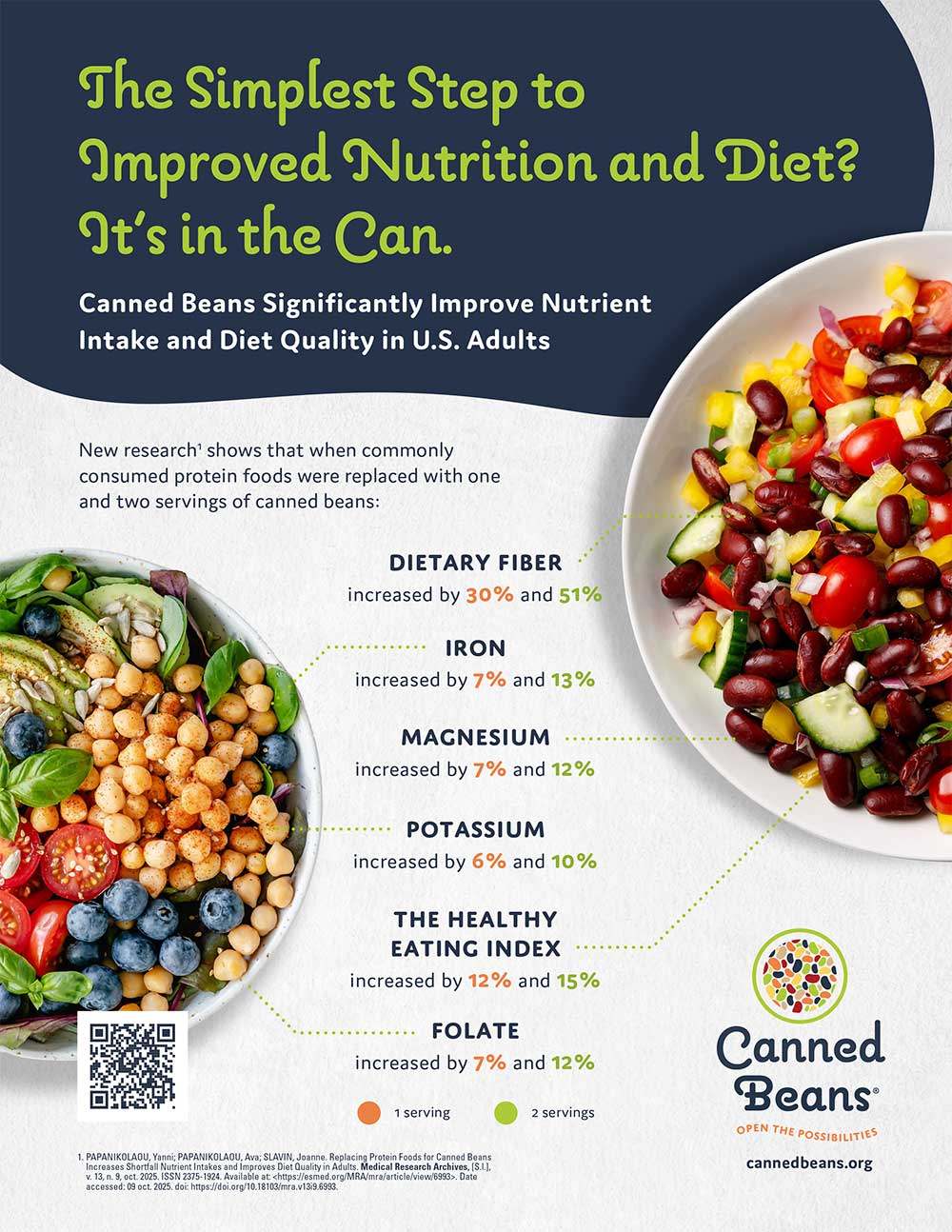Canned Beans Can Do!
New research showcases the health beanefits of CANNED BEANS SPECIFICALLY, augmenting the studies published in 2024 that support the nutrition beanefits of beans, peas, chickpeas and lentils.
New research demonstrates that replacing commonly consumed protein foods* with one and two servings of canned beans** significantly increased shortfall nutrient intakes and improved diet quality in adults in the United States, as noted in the infographic below.
Other notable outcomes:
- Canned beans serve as a significant source of protein while contributing minimal total sugar and no added sugar, per 138.5 total calories.
- While sodium contribution is elevated, the sodium to potassium ratio is greater than 1.0, thus, falling into recommendations set forth by the American Heart Association to add more potassium-rich foods to dietary patterns to blunt the effects of sodium.
* The protein foods composite was based on all foods within the USDA protein foods category (i.e., meats, poultry, eggs, seafood, nuts, seeds and soy products).
** Beans included kidney beans, black beans, chickpeas and pinto beans.
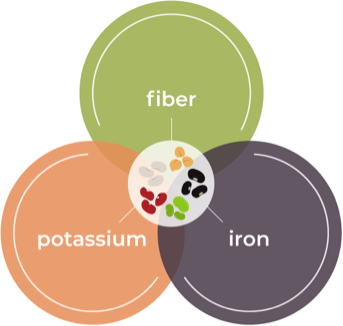
Three studies published in 2024 demonstrated that beans are positively associated with overall nutrient intake, nutrient adequacy, diet quality, and biomarkers of health. Their high fiber content makes them great for individuals trying to reduce or manage their weight. Their low glycemic index makes them ideal for people with diabetes. Their plant-based natural protein content makes them perfect for those looking to reduce or eliminate animal proteins. Beans have been shown to help prevent heart disease, lower cholesterol, and improve gut health. In short, beans are considered by some to be Mother Nature’s most perfect food.
Research conducted in 2022 among RDNs and consumers revealed that RDNs know most of this information. However, consumers do not. Cannedbeans.org needs your help to educate consumers about how simply, nutritiously, and deliciously canned beans can positively impact health. In addition to providing objective reasons why it is important to eat beans more often, Cannedbeans.org is packed with recipes and usage suggestions to add more beans to the diet.
Let’s Take a Closer Look at Each Study…
Pulse Consumption and Health Outcomes: A Scoping Review
Published in Nutrients, May 2024
This research included in this scoping review underscores the integral role of pulses (beans, peas, lentils and chickpeas) in the management of Type 2 Diabetes Mellitus (T2DM) and corroborates the beneficial effects of pulses on key cardiovascular biomarkers, such as LDL cholesterol and HDL cholesterol.

- This assessment aimed to examine the amount and types of evidence available around how pulses contribute to overall human health.
- Researchers identified thirty articles that studied lentils, chickpeas, common bean varieties (e.g., pinto, black, navy, red, kidney), black-eyed peas, cowpeas and split peas. The health outcomes in these studies were multifaceted, ranging from lipid profiles to blood pressure, cardiovascular disease risk and mortality, type 2 diabetes and glycemic control, metabolic syndrome indicators, inflammatory markers, oxidative stress biomarkers, and hormonal profiles.
- The most frequently assessed study outcomes included changes in low-density lipoprotein cholesterol, high-density lipoprotein cholesterol, systolic blood pressure, diastolic blood pressure, fasting blood sugar, hemoglobin A1c, waist circumference, and C-reactive protein or high-sensitivity C-reactive protein.
Adult dietary patterns with increased bean consumption are associated with greater overall shortfall nutrient intakes, lower added sugar, improved weight-related outcomes and better diet quality
Published in Nutrition Journal, March 2024
This research demonstrates that eating beans (including canned and/or dry packaged kidney beans, black beans, and/or pinto beans) and chickpeas is associated with greater intake of shortfall nutrients, including nutrients of public health concern, and significantly higher diet quality scores. Additionally, the study finds that bean and/or chickpea consumption is associated with improved weight-related outcomes, including lower body mass index, body weight, and improved waist circumference.
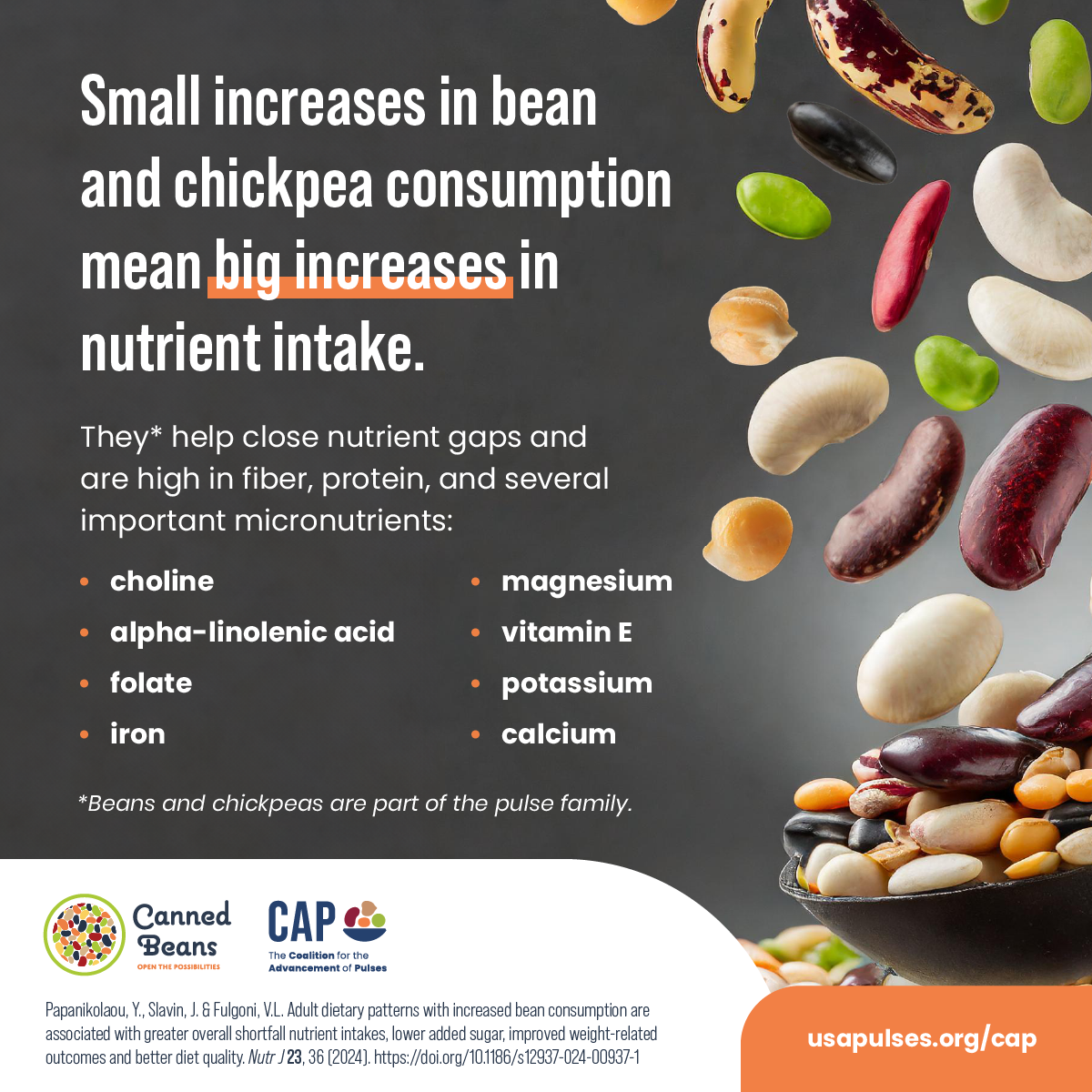
- Researchers analyzed data from the National Health and Nutrition Examination Survey, 2001-2018, to identify patterns of bean and/or chickpea consumption compared to those who do not consume any beans or chickpeas.
- Results show that adults who consume beans and/or chickpeas daily have significantly higher diet quality scores compared to those who do not.
- Bean and/or chickpea consumers also have significantly higher intakes of several shortfall nutrients, including choline, alpha linolenic acid, folate, iron, magnesium, and vitamin E. Similarly, dietary fiber, potassium, and calcium (nutrients of public health concern) are significantly higher in the diets of bean and/or chickpea consumers.
- Finally, the study showed that adults who consume 1.7-2.0 servings of beans and/or chickpeas per day had significantly lower Body Mass Index (BMI), decreased body weight, and smaller waist sizes compared to the non-bean and/or chickpea consumers.
Adding more beans to the US typical dietary pattern can lead to greater intake of shortfall nutrients and a higher diet quality in younger and older adults
Published in Maturitas, August 2024
This research demonstrates that eating beans (including canned and/or dry packaged kidney beans, black beans, and/or pinto beans) and chickpeas is associated with greater intake of shortfall nutrients, including nutrients of public health concern, and significantly higher diet quality scores in both younger and older adults.

- Using data from the National Health and Nutrition Examination Survey (NHANES), 2001-2018, researchers modeled the addition of one and two servings of canned and dried beans and chickpeas in younger and older adults to assess the effect of increased bean and chickpea consumption, in the typical American dietary pattern. They examined impact on shortfall-nutrient intakes and diet-quality outcomes.
- Results show significant increases in several shortfall nutrients, including dietary fiber, potassium, magnesium, iron, folate, and choline. In fact, adding either one or two servings of beans and/or chickpeas daily to the US typical dietary pattern significantly increased overall diet quality in both younger and older adults.
- Total diet quality, as measured by The Healthy Eating Index – 2015 scores, was 15-16% greater with one additional serving of beans and/or chickpeas, and 19-20% higher with two additional servings of beans and/or chickpeas relative to the US typical dietary pattern.
Effect of Adding Pulses to Replace Protein Foods and Refined Grains in Healthy Dietary Patterns
Published in Nutrients, October 2023
This research shows that swapping ¼ cup of pulses per day in place of one ounce protein foods increases fiber, a nutrient of concern, and decreases cholesterol, each by more than 10%.
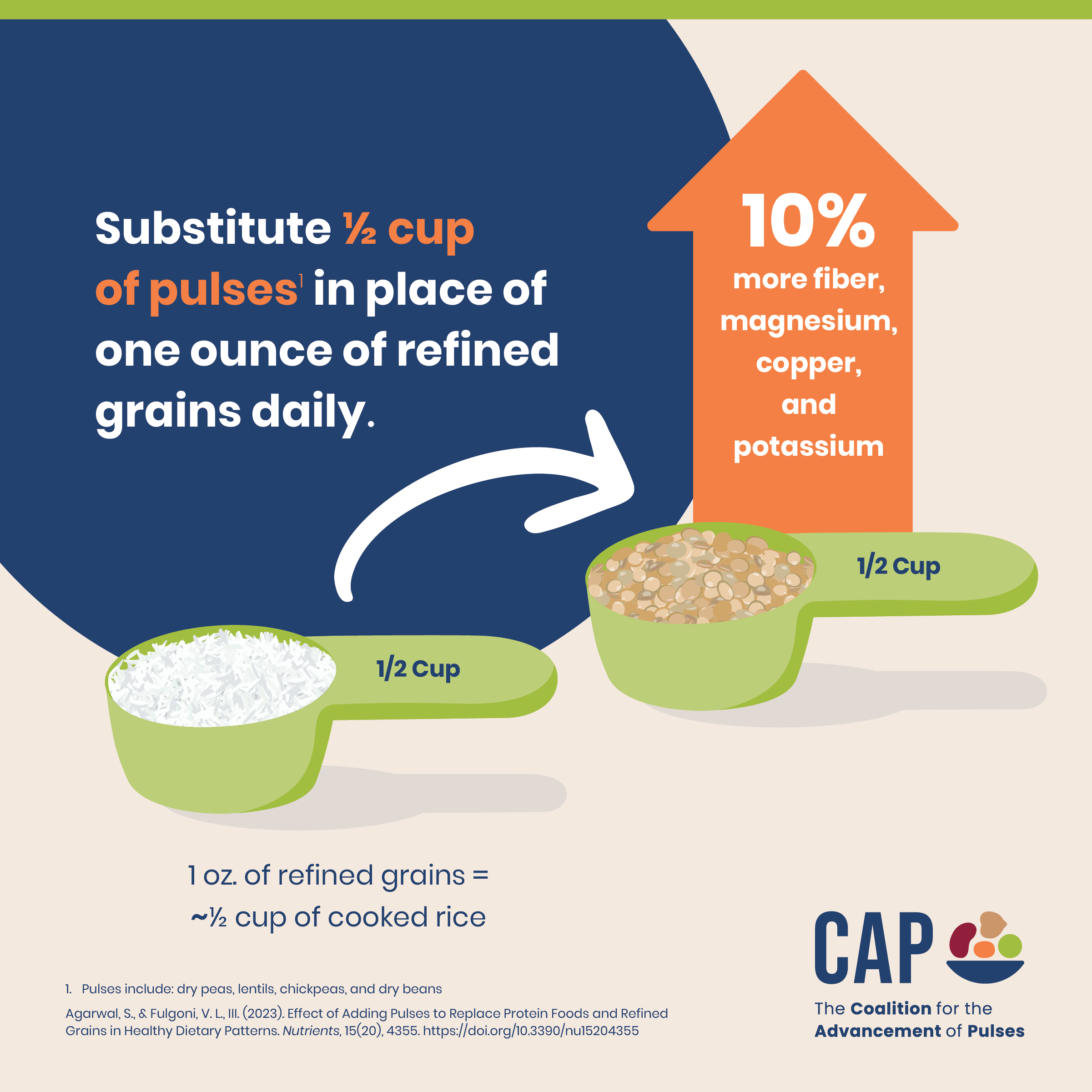
- Researchers modeled the nutritional impact of substituting servings of protein foods and/or refined grains with servings of pulses (e.g., dry peas, lentils, chickpeas, dry beans) while keeping calories consistent in the Healthy U.S.-Style Dietary Pattern identified in the 2020-2025 Dietary Guidelines for Americans.
- The addition of about ¼ cup of pulses per day in place of one ounce per day of common protein foods increases fiber, a nutrient of concern, and decreases cholesterol, each by more than 10%.
- Researchers found that substituting ½ cup of pulses daily in place of one ounce of refined grains daily also while keeping calories constant increases fiber, magnesium, copper, and potassium, a nutrient of concern, by more than 10%.

What are the Nutrients of Public Health Concern?
Low intakes of recommended nutrient-dense foods and beverages have resulted in underconsumption of certain nutrients and dietary components. According to the 2020-2025 Dietary Guidelines for Americans, calcium, potassium, dietary fiber, and vitamin D are considered nutrients of public health concern for the general U.S. population. In addition, iron is a nutrient of public health concern for infants starting at about age 6 months receiving mostly human milk and people who are pregnant.
What is NHANES?
- The National Health and Nutrition Examination Survey (NHANES) is a program of studies designed to assess the health and nutritional status of adults and children in the United States. The survey is unique in that it combines interviews and physical examinations. NHANES is a major program of the National Center for Health Statistics (NCHS). NCHS is part of the Centers for Disease Control and Prevention (CDC) and has the responsibility for producing vital and health statistics for the Nation.
- The NHANES interview includes demographic, socioeconomic, dietary, and health-related questions. The examination component consists of medical, dental, and physiological measurements, as well as laboratory tests administered by highly trained medical personnel.
- Beginning in 1999, NHANES became a continuous annual survey, collecting data every year from a representative sample of the U.S. civilian noninstitutionalized population, newborns and older, through in-home personal interviews and health examinations in the Mobile Examination Center (MEC).
- Findings from this survey will be used to determine the prevalence of major diseases and risk factors for diseases. Information will be used to assess nutritional status and its association with health promotion and disease prevention.
- NHANES findings are also the basis for national standards for such measurements as height, weight, and blood pressure. Data from this survey will be used in epidemiological studies.
Press Releases Announcing Research Presentations at Professional Conferences
These contemporary studies along with multiple studies published over the years call for dietary strategies that promote increased pulse consumption be considered when drafting new nutrition guidance. We know you know beans have always been good for you, based on the existing body of evidence , but now you have new reasons to believe.



